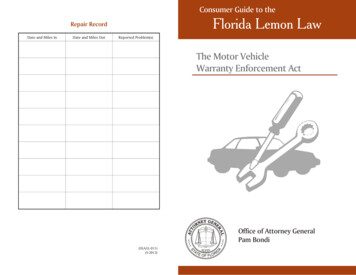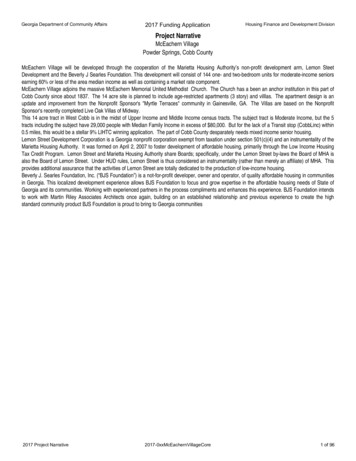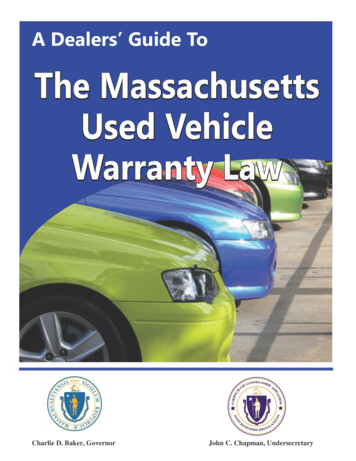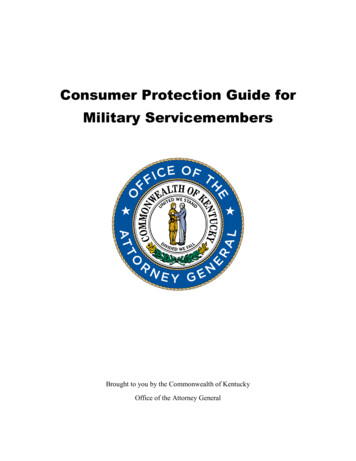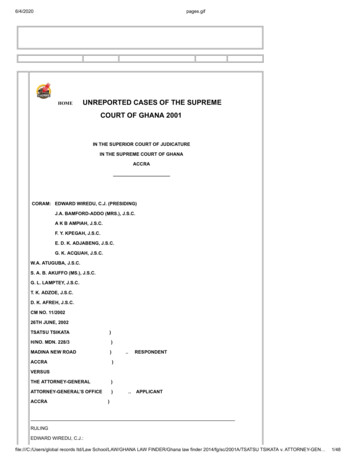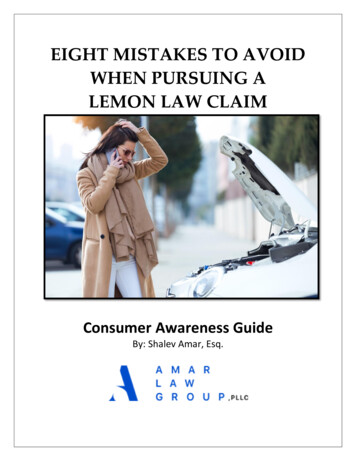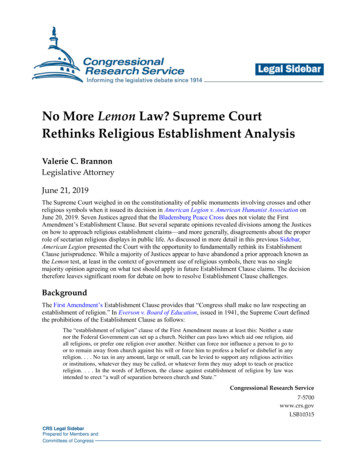
Transcription
Legal SidebariNo More Lemon Law? Supreme CourtRethinks Religious Establishment AnalysisValerie C. BrannonLegislative AttorneyJune 21, 2019The Supreme Court weighed in on the constitutionality of public monuments involving crosses and otherreligious symbols when it issued its decision in American Legion v. American Humanist Association onJune 20, 2019. Seven Justices agreed that the Bladensburg Peace Cross does not violate the FirstAmendment’s Establishment Clause. But several separate opinions revealed divisions among the Justiceson how to approach religious establishment claims—and more generally, disagreements about the properrole of sectarian religious displays in public life. As discussed in more detail in this previous Sidebar,American Legion presented the Court with the opportunity to fundamentally rethink its EstablishmentClause jurisprudence. While a majority of Justices appear to have abandoned a prior approach known asthe Lemon test, at least in the context of government use of religious symbols, there was no singlemajority opinion agreeing on what test should apply in future Establishment Clause claims. The decisiontherefore leaves significant room for debate on how to resolve Establishment Clause challenges.BackgroundThe First Amendment’s Establishment Clause provides that “Congress shall make no law respecting anestablishment of religion.” In Everson v. Board of Education, issued in 1941, the Supreme Court definedthe prohibitions of the Establishment Clause as follows:The “establishment of religion” clause of the First Amendment means at least this: Neither a statenor the Federal Government can set up a church. Neither can pass laws which aid one religion, aidall religions, or prefer one religion over another. Neither can force nor influence a person to go toor to remain away from church against his will or force him to profess a belief or disbelief in anyreligion. . . . No tax in any amount, large or small, can be levied to support any religious activitiesor institutions, whatever they may be called, or whatever form they may adopt to teach or practicereligion. . . . In the words of Jefferson, the clause against establishment of religion by law wasintended to erect “a wall of separation between church and State.”Congressional Research Service7-5700www.crs.govLSB10315CRS Legal SidebarPrepared for Members andCommittees of Congress
Congressional Research Service2As suggested in the above quotation, the Court has held that the Establishment Clause’s protectionsexceed what the plain text might suggest: the Clause prohibits more than formal governmentestablishments of national religions, and applies beyond “Congress,” to the entire federal government andalso to states, through the Fourteenth Amendment.In the decades since, the Court has grappled with how to determine whether any given government actionis sufficiently “neutral” towards religion. As described in this Sidebar, the Court’s opinions have adopteda few different tests to guide their Establishment Clause analyses. The primary analysis has been theLemon test, which says that for a government action to be constitutional, (1) it “must have a secularlegislative purpose;” (2) “its principal or primary effect must be one that neither advances nor inhibitsreligion;” and (3) it “must not foster an excessive government entanglement with religion.” In later cases,the Court applied an “endorsement” test developed from Lemon, asking whether a “reasonable observer”would think that a government practice “has the purpose or effect of ‘endorsing’ religion.” However, theCourt does not always apply Lemon in its Establishment Clause decisions. Further, various Justices havecriticized the Lemon test, arguing that it is not “based on either the language or intent” of those whodrafted the Constitution and that the test is inconsistently applied. Nonetheless, the Supreme Court hasused Lemon to analyze the constitutionality of various government displays that involve religioussymbols, approving of some and ruling that others violate the First Amendment depending on theparticular factual circumstances.By contrast, however, in Van Orden v. Perry, issued in 2005, four members of the Court concluded thatthe Lemon framework was “not useful” to analyze “passive monument[s]” like the Ten Commandmentsdisplay at issue in that case. Instead, the plurality opinion looked to “the nature of the monument and . . .our Nation’s history” in holding that the monument did not violate the Establishment Clause. However,Justice Breyer, providing the fifth vote to uphold the monument, looked to the totality of thecircumstances, using the Lemon factors as a “useful guidepost[]” in the inquiry. Among other factors, hestressed that the monument had stood on the grounds of the Texas state capitol for 40 years withoutanyone objecting. In in his opinion, this suggested that “few individuals . . . understood the monument” asimpermissibly promoting religion. Under these circumstances, Justice Breyer argued that removing themonument might exhibit a “hostility toward religion” that could “create the very kind of religiously baseddivisiveness that the Establishment Clause seeks to avoid.”More recently, in Town of Greece v. Galloway, decided in 2014, the Court did not invoke Lemon at all, butinstead employed what has since been described as a “history and tradition” test. In that case, the Courtconsidered whether a town violated the Establishment Clause by opening its monthly board meetings withsectarian prayers. The majority opinion approved of the practice because it “fit[] within the tradition [oflegislative prayer] long followed in Congress and the state legislatures.” The Court concluded that “theEstablishment Clause must be interpreted by reference to historical practices and understandings.”Amidst this backdrop, the plaintiffs in American Legion challenged the constitutionality of theBladensburg Peace Cross. They argued that Maryland violated the Establishment Clause by maintainingthis war memorial, a 40-foot-tall Latin cross. Applying the Lemon test, the U.S. Court of Appeals for theFourth Circuit agreed with these challengers. In short, the appellate court held that the “immense size andprominence of the [Peace] Cross” outweighed its few secular elements. Although the base of themonument had a plaque with the names of local soldiers who died in World War I and was inscribed withthe words “valor,” “endurance,” “courage,” and “devotion,” the court emphasized that these secularelements were not readily visible to onlookers, most of whom would be viewing the Peace Cross fromtheir cars. Accordingly, the court held that “a reasonable observer would fairly understand the Cross tohave the primary effect of endorsing religion.”
Congressional Research Service3The Supreme Court’s Seven OpinionsThe Supreme Court reversed the lower court decision, holding that Maryland’s maintenance of the PeaceCross did not violate the Establishment Clause. Although seven Justices ultimately approved of the PeaceCross, they did so in six different opinions, reflecting disagreement about how, exactly, to resolve thecase. Justice Alito wrote the opinion for the Court, joined by Chief Justice Roberts and Justices Breyer,Kagan, and Kavanaugh. Certain portions of that opinion represented only a plurality, however, as JusticeKagan declined to join those sections. Justices Breyer, Kagan, and Kavanaugh also filed concurrences, asdid Justices Thomas and Gorsuch. Thus, while Justices Thomas and Gorsuch joined in the judgment ofthe Court and seemed to agree with at least some aspects of the plurality opinion, they did not join JusticeAlito’s opinion. Finally, Justice Ginsburg dissented, joined by Justice Sotomayor.Justice Alito’s opinion first considered whether to apply Lemon to analyze the constitutionality of thePeace Cross. Writing for only a plurality, Justice Alito detailed the shortcomings of the Lemon test, notingthat the Supreme Court itself had declined to apply this framework in a number of cases. Resuming amajority, the opinion then reviewed a number of factors that “counsel[ed] against” applying Lemon togovernment uses of religious symbols. The Court stated that when assessing “monuments, symbols, orpractices that were first established long ago,” it can be difficult to determine the government’s “purpose”in using these symbols, particularly because these purposes can “multiply” over time. The messagesconveyed by these symbols may also change, and the Court said that “[w]ith sufficient time, religiouslyexpressive monuments, symbols, and practices can become embedded features of a community’slandscape and identity.” Under these circumstances, the Court concluded that removing such a monument“may no longer appear neutral,” but could instead be interpreted as “aggressively hostile to religion,”citing Justice Breyer’s concurring opinion in Van Orden. Concluding its analysis of what test was mostappropriate under the circumstances, a plurality of the Court noted that in other cases, the Court has notemployed Lemon, but instead has “taken a more modest approach that focuses on the particular issue athand and looks to history for guidance.” The plurality said that “monuments, symbols, and practices witha longstanding history” should be judged under this approach and upheld if they follow “tradition.”The remainder of Justice Alito’s opinion, in which he held that the Peace Cross did not violate theEstablishment Clause, represented a majority of the Court. The majority acknowledged that the cross is aChristian symbol, but decided that “the symbol took on an added secular meaning when used in WorldWar I memorials.” In the view of the Court, the Peace Cross itself had “acquired historical importance” tothe Bladensburg community. Consequently, the Court concluded that “destroying or defacing the Crossthat has stood undisturbed for nearly a century would not be neutral and would not further the ideals ofrespect and tolerance embodied in the First Amendment.”Justice Breyer wrote a separate concurrence joined by Justice Kagan, primarily to restate his belief “thatthere is no single formula for resolving Establishment Clause challenges.” Instead, he based his decisionthat the Peace Cross was constitutional on a review of all the factual circumstances, emphasizing thatdifferent facts might change his view of the case. He also stated that he did not view the majority opinionas adopting a “‘history and tradition test’ that would permit any newly constructed religious memorial onpublic land” regardless of the particular circumstances.Justice Kagan said in her own concurring opinion that while she agreed with most of the majorityopinion, she believed that Lemon’s “focus on purposes and effects is crucial in evaluating governmentaction in this sphere.” Further, while she agreed that history and tradition may be significant factors in anEstablishment Clause analysis, she did not want to “sign on to any broader statements about history’s rolein Establishment Clause analysis.”Justice Kavanaugh also wrote separately, agreeing that the Supreme Court has never consistently appliedthe Lemon test. Instead, he said that the Court’s jurisprudence revealed a distinct “overarching set ofprinciples:”
Congressional Research Service4If the challenged government practice is not coercive and if it (i) is rooted in history and tradition;or (ii) treats religious people, organizations, speech, or activity equally to comparable secularpeople, organizations, speech, or activity; or (iii) represents a permissible legislativeaccommodation or exemption from a generally applicable law, then there ordinarily is noEstablishment Clause violation.However, Justice Kavanaugh emphasized that government actions “outside” this “safe harbor” might stillbe judged unconstitutional under appropriate circumstances. In his opinion, the Peace Cross did notviolate the Establishment Clause because “[t]he practice of displaying religious memorials, particularlyreligious war memorials, on public land is not coercive and is rooted in history and tradition.”Justice Thomas concurred in the judgment, writing separately to reiterate his own view of theEstablishment Clause. He first called again for the Court to reconsider whether the Establishment Clausedoes in fact apply to the states, or whether instead it applies only to “‘law[s]’ enacted by ‘Congress,’” perthe text of the First Amendment. In addition, Justice Thomas argued that the Court should evaluateEstablishment Clause claims by reference to historical forms of “coercion” and clarified that he would“overrule the Lemon test in all contexts.” He would have held that the Peace Cross was constitutionalbecause the challengers had “not demonstrated that maintaining a religious display on public propertyshares any of the historical characteristics of an establishment of religion.” The state had not committedany acts of coercion, according to Justice Thomas, because it had “not attempted to control religiousdoctrine or personnel, compel religious observance, single out a particular religious denomination forexclusive state subsidization, or punish dissenting worship.”Justice Gorsuch also concurred in the Court’s judgment and did not join the majority opinion. In aseparate opinion joined by Justice Thomas, Justice Gorsuch argued that the Court should have dismissedthe case because the groups challenging the Peace Cross lacked standing. In order to bring a legal claim,the concept of standing, which derives from Article III of the Constitution, requires plaintiffs to show(among other things) that they have suffered a concrete and particularized injury. Justice Gorsuch saidthat it was insufficient for the plaintiffs to show that they were “offended” by the monument, given thatthe Supreme Court has generally “rejected the notion that offense alone qualifies” as an injury for ArticleIII standing purposes. In his view, mere “offended observers” should not be able to litigate EstablishmentClause violations. While Justice Gorsuch primarily focused on this procedural issue, he also offered histhoughts on the plurality’s approach to the case, saying that while he approved of a “historicallysensitive” approach to religious claims, he was less sure that “‘longstanding monuments, symbols, andpractices’ are ‘presumpt[ively]’ constitutional.” He raised practical and theoretical concerns about such apresumption for “old” monuments. Instead, he said that the Supreme Court’s message should be“unmistakable”: “Whether a monument, symbol, or practice is old or new, apply Town of Greece, notLemon.” According to Justice Gorsuch, government actions must be judged by whether they comply withthe “ageless principles” set down in the Constitution.In dissent, Justice Ginsburg stressed the cross’s religious nature, noting that it has become a marker forChristian soldiers’ graves “precisely because” the cross symbolizes “sectarian beliefs.” She stated that“[b]y maintaining the Peace Cross on a public highway, [the state] elevates Christianity over other faiths,and religion over nonreligion.” Even though the state’s purpose of “memorializing the service ofAmerican soldiers” was both secular and permissible, in her view, the state could not “serve this objectiveby displaying a symbol that bears ‘a starkly sectarian message.’” To reach this conclusion, JusticeGinsburg employed the endorsement test, an offshoot of Lemon, but did not cite Lemon itself. She askedwhether the government display “ha[d] the ‘effect of endorsing religion.’” Applying this analysis, sheargued that “when a cross is displayed on public property, the government may be presumed to endorse itsreligious content.” And according to her, the circumstances surrounding the Peace Cross confirmed thememorial’s sectarian, religious character.
Congressional Research Service5Implications for Congress and Federal LawThe various opinions in this case confirm the Court’s pivot away from the Lemon test, following the VanOrden plurality decision in 2005 and Town of Greece in 2014. Of all the Justices, only Justice Kaganexplicitly argued that the Lemon factors should continue to inform the Court’s analysis of EstablishmentClause claims, although the dissenting opinion also employed an endorsement test that was built onLemon. Instead, a majority of the Court’s members have said that they will now look primarily to historyand tradition to assess the constitutionality of at least some government actions. However, due to thefractured nature of these opinions, it is not clear that the Court has settled on a replacement for the Lemontest. The plurality opinion stated that “monuments, symbols, and practices with a longstanding history”should be evaluated by reference to historical practices. But although Justices Breyer and Kavanaughjoined this plurality, their separate opinions suggested that they would also consider other factors, perhapsallowing some of the same types of considerations that fell under the Lemon rubric to remain relevant.Justice Thomas reiterated his view that only historically grounded forms of coercion violate theEstablishment Clause, but also joined Justice Gorsuch’s opinion arguing that the appropriate test waswhether a given monument or practice was consistent with historical practices.In addition, Justice Gorsuch’s opinion may prompt governments in the future to more vigorously contestwhether plaintiffs challenging state actions have proved that they have standing to bring suit. It is unclear,though, whether a majority of the Court agrees with his more narrow view of Establishment Clausestanding. Justice Thomas joined his opinion, and Justice Kavanaugh, while a judge on the U.S. Court ofAppeals for the D.C. Circuit, suggested that he might similarly believe that plaintiffs demonstrating only“offense” at a religious message could not demonstrate a sufficient injury. However, Justice Kavanaughdid not join Justice Gorsuch’s opinion. A narrower view of standing could significantly limit plaintiffs’ability to sue to vindicate violations of the Establishment Clause.Overall, the American Legion decision indicates that the Court is embracing a more accommodationistview of the Establishment Clause relative to at least some of its mid-to-late 20th Century cases. If this casedoes reflect a broader shift in the Court’s jurisprudence, such a shift could affect a wide variety ofEstablishment Clause challenges, allowing the government more leeway to accommodate sectarianreligious activities. The majority opinion concluded that at least with respect to government use ofreligious symbols, “[t]he passage of time gives rise to a strong presumption of constitutionality.” Thisstatement suggests that the Court may be more accommodating toward religion at least where a givenpractice has a long history.But while the Court appears to have abandoned Lemon in the context of government “monuments,symbols, and practices,” there may be questions about whether Lemon still applies to other types ofEstablishment Clause challenges. (And litigants may disagree about what may be classified as alongstanding “symbol” or “practice” that should be evaluated under the plurality’s “tradition” rubric.) Asdiscussed in this Sidebar, the Court’s Establishment Clause jurisprudence may govern a wide variety ofchallenges to federal actions. For example, lower courts are currently considering a few differentchallenges to a so-called “conscience rule” recently issued by the Department of Health and HumanServices (HHS). According to the agency, this rule “protects individuals and health care entities fromdiscrimination on the basis of their exercise of conscience in HHS-funded programs.” Some of thechallengers have cited the Lemon factors in arguing that this rule violates the Establishment Clause bycreating a preference for religion. To take another example, the U.S. Court of Appeals for the D.C. Circuitrecently rejected an Establishment Clause challenge to the U.S. House of Representative’s decision todeny an atheist’s request to serve as guest chaplain. Although the majority opinion in American Legiondid not clearly state what test should apply to Establishment Clause claims outside the context oflongstanding monuments or practices, the various opinions nonetheless suggest that historicalunderstandings of the Establishment Clause and the existence of analogous traditions will be importantfor many members of the Court in assessing whether a government action is constitutional.
Congressional Research Service6Looking to the more immediate consequences of the judgment, those who defended the Peace Crossduring oral argument had claimed that if the Supreme Court ruled the Cross unconstitutional, it wouldjeopardize the constitutionality of a variety of other government memorials containing religious symbols,including the Canadian Cross of Sacrifice in Arlington National Cemetery and the Irish Brigademonument at Gettysburg. The Court’s decision appears to allay those concerns by suggesting that crossesmay constitutionally be used to commemorate those who died in war—although as some of the Justicesemphasized, each monument must be reviewed on its own terms. And beyond monuments that involveLatin crosses, the majority opinion appears to create a strong presumption of constitutionality for anypublic displays that have stood for a number of years, although it is not clear how many years must passbefore a memorial is entitled to such a presumption.LSB10315 · VERSION 1 · NEW
No More Lemon Law? Supreme Court Rethinks Religious Establishment Analysis Valerie C. Brannon Legislative Attorney June 21, 2019 The Supreme Court weighed in on the constitutionality of public monuments involving crosses and other religious symbols when it issued its decision in American Legion v. American Humanist Association on June 20, 2019.
